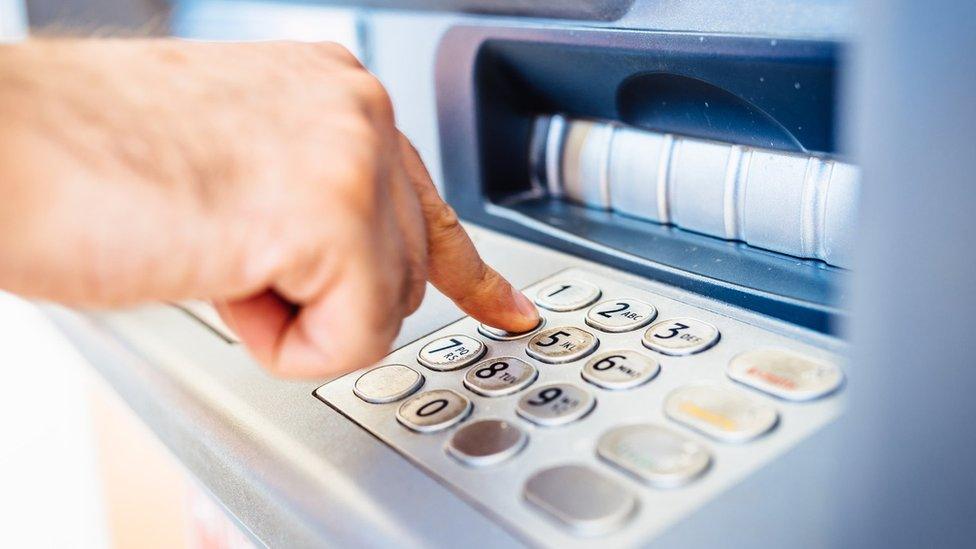Seismic change sees return of the weekly shop
- Published

A sudden seismic change in shopping has boosted convenience stores, home delivery and brought the return of the big weekly shop.
Cash is king for business, but the number of cash machine transactions is sharply down.
With less to spend on, a new forecast points to a doubling in UK household savings this year.

We know retail sales have boomed for food and tanked for non-food.
Kantar data specialists today give us some idea of who is doing best out of that grocery change.
That's while other data shows the use of cash machines falling away sharply, and those of us with spare cash are expected to squirrel away twice as much as last year.
Total grocery sales were up 9% in the 12 weeks to 19 April.
Those doing best were conveniently local; the Co-op growing most strongly at 20%, boosting its market share from 6.1 to 6.7%.

The Co-op has had its sales boosted as people shop locally
Also from a low share of the UK market, independents, Nisa and Londis were up nearly 40%. But that only succeeded in taking them over 2% of the grocery market.
It's possible that Kantar's focus, in its regular surveys drawing from data-rich big multiples, misses a lot of the indie corner shop business.
Aldi and Waitrose could both claim to have grown sales 9%, yet neither grew market share. Lidl only grew its share modestly, by the German retailers' usual standards of eating into the big retailers.
Tesco and Sainsbury's did best of the big four, helped by their home delivery services.
That comes at a cost. One analyst this week suggested the extra bill for infection control could top £400m for Sainsbury's.

Asda's grocery sales increased by a relatively poor 3.5%
Asda, without much convenience to its portfolio of giant stores, raised grocery sales a relatively poor 3.5%.
M&S also bet its food growth strategy on travel - people passing through railway stations and motorway services. That's not looking good this month.
Its non-food offer has been troubled for years, and it's in a lot more trouble now. Next month, it reveals a programme reflecting the permanent shifts in consumer behaviour that many expect post-lockdown. Its name: "never the same again".
The Kantar data suggests that older customers have been shifting in big numbers to online shopping and home delivery. That can't surprise anyone.
Tesco's chief executive, meanwhile, has told the BBC that the number of visits to stores has halved, but the big weekly shop is back, with the value of the average basket doubling.

And all the while, cash use is diminishing sharply. The Link network tells us today that there have been 60% fewer transactions. The average withdrawn is up from £65 to £82, but more than half of people are using cash a lot less than they were, and many intend to keep it that way.
That makes the ownership and operation of a lot more cash machines financially unattractive. RBS, Barclays, PayPoint and Sainsbury's Bank are promising, with 30% of the Link network, to ensure communities retain access to cash at least for the next year.
But there will surely be a renewed fight when this shakes down, assuming a further lurch towards using even less cash becomes permanent. For many shops already, cash is not only discouraged, but not accepted at all. That could be part of the "new normal".

UK companies face a cash-flow crisis as many have been forced to close due to the lockdown
Further evidence of mayhem in retail comes from the monthly CBI survey today. It says 67% of those surveyed had suffered a big hit from coronavirus, and 39% have shut completely.
It also shows a sharp rise in online retail, now at more than 22%. That may only ratchet upwards as more people get used to it and less comfortable about being in shops.
With less to spend on for those fortunate to have a job there's an estimate from the NIESR economic think tank of a big surge in household savings.
Last year, the ratio of UK money put into savings stood at 7%. The economists think it could go up to 17% this year, before falling back to 8% in 2021.
- Published28 April 2020

- Published29 April 2020

